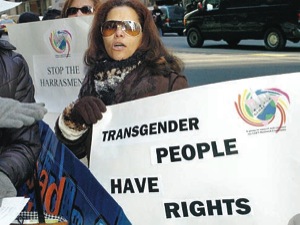
There is a case to be made for the T community falling under a sociopolitical LGBT community umbrella; there is a case to be made for why T community activism is a part of LGBT community activism.
I begin by looking at another sociopolitical umbrella community: the Asian Pacific Islander (API) community. There are differences between those of Samoan ancestry and those of Chinese ancestry; there are differences between those Americans who have familial or ancestral ties to Japan, and those Americans who have familial or ancestral ties to Indonesia. But along with differences between ethnic groups that fall under the API umbrella, there are also many similarities and many commonalities. And the commonalities include race-based discrimination—many of those who discriminate against API community members can’t tell a Korean American apart from a Chinese American or a Japanese American. These racists discriminate against all who have gathered under the API umbrella equally, because they don’t see any difference between the subcommunities of the Asian Pacific Islander community.
For similar reasons, there is a transgender umbrella and an LGBT umbrella. We have gathered under sociopolitical community umbrellas in part because the prejudice and discrimination we face is based on how homophobic/transphobic people don’t bother to differentiate between crossdressers, drag queens, feminine gay males and transsexual women. Also, because homophobic/ transphobic people don’t bother to differentiate between masculine lesbian women, drag kings and transsexual men. In their minds, we are all in violation of societal sex and gender norms. They don’t see any difference between the subcommunities of the LGBT community.
Everyone who is African American doesn’t appear to be black. In the African American community, its members are fa-miliar with the word “passing.” Be-fore the civil rights movements of the ‘50’s and ‘60’s, many African Ameri-cans who could pass as Caucasians hid their heritage and ancestry. Others who could “pass” chose not to publicly deny their race and stood with their African American brothers and sisters because the African American community was their community.
Many who are gay, lesbian or bisexual but can “pass” as straight, still publicly identify as gay, lesbian or bisexual —even when this subjects them to discrimination. Also many who are transsexual but can “pass” as natal men or women, still publicly identify as transgender—even when that exposes them to discrimination. Sometimes it’s not about the individual, but about the “we” of community.
With legislative or regulatory language, there is no way to protect against discrimination based upon the gender identity of transsexual people without protecting the gender expression of genderqueer people and crossdressers. When a newly out transsexual is in the workplace, protecting gender identity doesn’t protect their gender expression because they are still legally the opposite sex and gender. If an employer defines an individual as male, but the gender expression of that individual is female, the lack of protection for gender expression means an employer can fire someone in the first year of transition—assuming the transsexual follows the transition standards of the Harry Benja-min Standards of Care. For the protection of transsexual people in the workplace, one cannot separate gender identity and gender expression without providing employers a loophole for firing transsexual people early in transition.
The gender expression component of transsexual people is one that has commonality with the rest of the LGBT community.
The common interest in protecting the gender expression of feminine men, masculine women, and all people who choose to stand under the transgender umbrella, is probably the most important impetus for transgender community activism. Gender expression is the commonality that binds the transgender community and its activists.
School bullying of people who don’t conform to societal sex and gender norms is usually because they are presumed to be gay or lesbian. It’s that kind of bigotry that makes gender expression an LGBT community issue.
If sexual orientation becomes a protected class without gender identity and gender expression included, then employers and co-workers can discriminate against LGBT community members for appearing too feminine or too masculine.
Those involved in the practical considerations of drafting legislation and regulations know that language which addresses the issues of one narrowly defined group fails. For example, legislation that protects against discrimination against Chi-nese Americans, but not Ja-panese Americans, would leave gaping holes.
Legislative language that is not based on broader definitions is going to be exploited by people who wish to divide communities that share notable commonalities. Does anyone remember what happened with the Employment Non-Dis-cri-mi-na-tion Act of 2007/ 2008? The rift in the community that occurred when gender identity was taken out of ENDA ultimately didn’t benefit the gay, lesbian, and bisexual people who were left in the bill. The bill was never passed. We still don’t have a federal law that protects against discrimination based upon sexual orientation, let alone one that provides protection based upon sexual orientation, gender identity and gender expression. Broad community solidarity matters for any identity group pushing for freedom, equality, justice and civil rights.
Even if a significant number of individual transsexual people don’t want to fall under the transgender umbrella, there is a case to be made for transgender community activism. Many transsexual folk don’t want to be grouped together with drag performers, genderqueer people and crossdressers because they perceive these transgender community member groups as freakish and loathsome.
Whether you choose to identify as part of the transgender or LGBT communities is a personal choice. The sociopolitical umbrella com-munities will still exist for those who choose to step forward. Since we have at least the one common-ality of discrimination based upon gender expression, the sociopoliti-cal LGBT community exists and we are tied together in our pursuit for equality.











